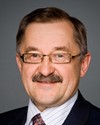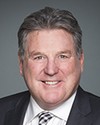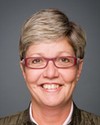Thank you very much, Mr. Chair.
I appreciate the opportunity to present on behalf of the Association of Faculties of Medicine of Canada. I would suggest that you pick up the document I have here. There is some data that I'll be referring to and referencing in some of the slides.
I would say right up front that you will find some of my comments—and in fact some of my information—very complementary to that which you've heard from the CMA. Notwithstanding the fact that we did not plan it that way, I am very appreciative of how clearly we represent similar views.
As you know, physicians are a highly skilled part of our workforce, and the care they provide is in high demand. At the same time, we continue to struggle with some shortages, particularly in rural and other underserviced areas. It is clear that if we're to meet the needs of Canadians, we need to achieve the right number, mix, and distribution of physicians. This is precisely what's being recommended through the future of medical education in Canada postgraduate project—FMEC PG.
In the following short presentation, I will outline why AFMC feels it is critically important to address certain physician shortages and also offer some specific strategies.
As you will note if you look at the second slide, our first recommendation from our report is to ensure the right number, mix, and distribution of physicians to meet societal needs. We've structured our report with what we consider to be key transformative actions. The transformative action to make that happen reads as follows: “create a national approach, founded on robust data, to establish and adjust the number and type of speciality positions needed in Canadian residency programs in order to meet societal needs”.
As you will see from that same slide, there are two other FMEC recommendations quoted, plus seven more recommendations that are in the report I have circulated. I encourage you to look at that report. I'd be pleased to answer any questions with regard to it.
The next slide, slide 3, talks about the growth in our trainees. The first and foremost way to achieve the right number of physicians is through our medical education system. In recent years, enrolment in undergraduate medical education has grown to levels that we have never seen before. What's shown in our chart is the flow of much larger medical classes through to postgraduate residency training.
The number of incoming medical residences has doubled over the decade, from 1,547 in 2000 to 2,912 in 2011. Residency programs are also an important entry point for international medical graduates, and that will be taken up in our next slide on the right numbers. As shown by the green line on that slide, since 2000 there has been a 400%-plus increase in the number of international medical graduates entering MD training. At all levels—not only at the entry level, but throughout the system—there are 2,139 IMGs enrolled in Canada's post-MD training programs. This represents approximately 17% of all residents training in medicine in Canada.
Slide 5 shows you a map of our country. The map shows where medical education currently happens in Canada. We have 18 main medical campuses situated in relatively large cities, spanning the country from St. John's, Newfoundland, to Vancouver, British Columbia. In addition, we have 13 satellite campuses situated in communities like Moncton, New Brunswick, Windsor, Ontario, and Prince George, British Columbia.
Finally, we have about 900 small clinical teaching facilities, many of which are in doctors' offices and clinics in rural communities. These teaching sites are situated in communities that are frequently most in need of physicians. Apart from aiming for the right number of physicians, we also need to train an appropriate number of family doctors, other specialists, and scientists.
I'll say a word about shifting demographics. Our next slide shows that, in 2001, 13% of Canadians were aged 65 or older. It is estimated that by 2036 one in four Canadians will be 65 or older. This demographic shift will create and in fact is creating new demands on our health care system. We may ask ourselves if the mix of physicians we're training today will be poised to care for tomorrow's elderly.
That takes us to the next slide and the comment made by Dr. Haggie. Enrolment increases in pediatric residency programs look very much like the overall increase in our postgraduate programs; however, the picture is dramatically different for geriatric medicine and programs for care of the elderly. Over the past decade, relatively few doctors have taken the opportunity to train in geriatric medicine and care of the elderly. You will see the numbers, as highlighted by Dr. Haggie, in the next graph.
It is imperative, in our view, that a multi-stakeholder forum be established to identify, prioritize, and address areas where the training of future health care providers can be brought into greater alignment with future health care needs. AFMC would like to take this opportunity to repeat its call for such a forum. I would also like to remind you that in the report of the House of Commons Standing Committee on Health, “Promoting Innovative Solutions to Health Human Resources Challenges”, the committee made this its number one recommendation.
We propose that a national health human resources data and analysis centre be established to provide a formal structure for the collection and analysis of Canada's disparate data sets, the collection of data where needed, and to serve as a resource to governments, federal and provincial, in matters of policy planning for health human resources. The centre would bring together caregivers, patients, federal, provincial, and territorial governments, managers, researchers, and other stakeholders to analyze data, make evidence-based recommendations, and build consensus around forward-looking strategies.
As a first step, AFMC is proposing that it form a secretariat for this initiative and hold a series of national, regional, and provincial consultations that would culminate in an actionable business plan, including a budget for such a centre. The anticipated cost for this work is $600,000. The work could be completed within two years.
Thank you for your time.
If there is any time, I'd be pleased to answer any questions.




